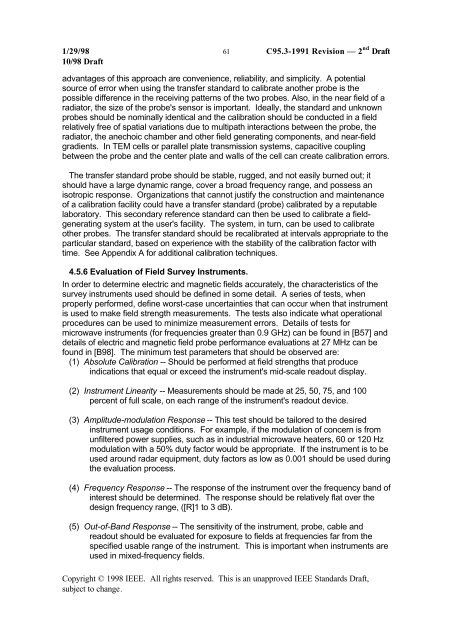DRAFT Recommended Practice for Measurements and ...
DRAFT Recommended Practice for Measurements and ...
DRAFT Recommended Practice for Measurements and ...
You also want an ePaper? Increase the reach of your titles
YUMPU automatically turns print PDFs into web optimized ePapers that Google loves.
1/29/98 61 C95.3-1991 Revision — 2 nd Draft<br />
10/98 Draft<br />
advantages of this approach are convenience, reliability, <strong>and</strong> simplicity. A potential<br />
source of error when using the transfer st<strong>and</strong>ard to calibrate another probe is the<br />
possible difference in the receiving patterns of the two probes. Also, in the near field of a<br />
radiator, the size of the probe's sensor is important. Ideally, the st<strong>and</strong>ard <strong>and</strong> unknown<br />
probes should be nominally identical <strong>and</strong> the calibration should be conducted in a field<br />
relatively free of spatial variations due to multipath interactions between the probe, the<br />
radiator, the anechoic chamber <strong>and</strong> other field generating components, <strong>and</strong> near-field<br />
gradients. In TEM cells or parallel plate transmission systems, capacitive coupling<br />
between the probe <strong>and</strong> the center plate <strong>and</strong> walls of the cell can create calibration errors.<br />
The transfer st<strong>and</strong>ard probe should be stable, rugged, <strong>and</strong> not easily burned out; it<br />
should have a large dynamic range, cover a broad frequency range, <strong>and</strong> possess an<br />
isotropic response. Organizations that cannot justify the construction <strong>and</strong> maintenance<br />
of a calibration facility could have a transfer st<strong>and</strong>ard (probe) calibrated by a reputable<br />
laboratory. This secondary reference st<strong>and</strong>ard can then be used to calibrate a fieldgenerating<br />
system at the user's facility. The system, in turn, can be used to calibrate<br />
other probes. The transfer st<strong>and</strong>ard should be recalibrated at intervals appropriate to the<br />
particular st<strong>and</strong>ard, based on experience with the stability of the calibration factor with<br />
time. See Appendix A <strong>for</strong> additional calibration techniques.<br />
4.5.6 Evaluation of Field Survey Instruments.<br />
In order to determine electric <strong>and</strong> magnetic fields accurately, the characteristics of the<br />
survey instruments used should be defined in some detail. A series of tests, when<br />
properly per<strong>for</strong>med, define worst-case uncertainties that can occur when that instrument<br />
is used to make field strength measurements. The tests also indicate what operational<br />
procedures can be used to minimize measurement errors. Details of tests <strong>for</strong><br />
microwave instruments (<strong>for</strong> frequencies greater than 0.9 GHz) can be found in [B57] <strong>and</strong><br />
details of electric <strong>and</strong> magnetic field probe per<strong>for</strong>mance evaluations at 27 MHz can be<br />
found in [B98]. The minimum test parameters that should be observed are:<br />
(1) Absolute Calibration -- Should be per<strong>for</strong>med at field strengths that produce<br />
indications that equal or exceed the instrument's mid-scale readout display.<br />
(2) Instrument Linearity -- <strong>Measurements</strong> should be made at 25, 50, 75, <strong>and</strong> 100<br />
percent of full scale, on each range of the instrument's readout device.<br />
(3) Amplitude-modulation Response -- This test should be tailored to the desired<br />
instrument usage conditions. For example, if the modulation of concern is from<br />
unfiltered power supplies, such as in industrial microwave heaters, 60 or 120 Hz<br />
modulation with a 50% duty factor would be appropriate. If the instrument is to be<br />
used around radar equipment, duty factors as low as 0.001 should be used during<br />
the evaluation process.<br />
(4) Frequency Response -- The response of the instrument over the frequency b<strong>and</strong> of<br />
interest should be determined. The response should be relatively flat over the<br />
design frequency range, ([R]1 to 3 dB).<br />
(5) Out-of-B<strong>and</strong> Response -- The sensitivity of the instrument, probe, cable <strong>and</strong><br />
readout should be evaluated <strong>for</strong> exposure to fields at frequencies far from the<br />
specified usable range of the instrument. This is important when instruments are<br />
used in mixed-frequency fields.<br />
Copyright © 1998 IEEE. All rights reserved. This is an unapproved IEEE St<strong>and</strong>ards Draft,<br />
subject to change.
















